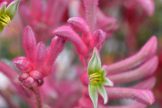
How to keep them thriving indoors in Melbourne!
Please Note: The information below is specific to this particular variety. For more detailed notes on the general growing conditions required for all Indoor Plants, check out our ‘Indoor Plant Care and Maintenance’ factsheet.
These gorgeous orchids, commonly called Moth Orchids, are the perfect orchid for the novice to grow. Showy but elegant, these orchids are easy to grow from year to year once you understand their simple needs and their life cycle. Sadly, owners misunderstand their dormant phase and throw them out, when within another month they would enter their growth period and regain their lustre. Read on and learn how to enjoy an annual flowering from your Phalaenopsis, and may it be just the beginning of a love affair with this wonderful genus.
Watering
Allow the bark mixture to almost dry out in between watering. With warmer weather in Melbourne you may need to increase watering to every second day in summer, but generally once a week or so. It is critical that the water freely drains from the pot and doesn’t accumulate at the base.
Light
Phalaenopsis need moderate to bright indirect light all year.
Temperature and humidity
For most of the year they like between 22C and 29C. HOWEVER, for several weeks in autumn they need to have cooler temperatures in order to initiate flowering. Night time temperatures need to drop to 16C-18C.
They like some humidity so setting your orchids on feet to keep the base free of water, but allowing water to collect underneath, is helpful.
Fertilising
Phalaenopsis have three growth phases, the flowering phase – you generally buy your orchid during this phase, followed by a dormant or resting phase (it is at this time that the orchid is most at risk of being thrown out!) and finally the growth phase.
Fertilise your orchid weekly with liquid fertiliser using a flowering phase food when flowering, and then reducing fertilising to every second week during the dormant or resting phase. The dormant phase begins once the flowering spike starts to fail. The leaves become floppy and often lose their lustre and even become a bit wrinkled. All perfectly normal and lasting only one to two months. Think of it as your orchid regrouping for the next period in its cycle, the growth phase. Now you need to increase fertilising back to weekly and use a fertiliser for a growth period (it will have a higher Nitrogen balance). Over the growth phase the leaves will regain their lustre and one or two new leaves and roots will appear. Once autumn begins you need to allow the orchid to experience cooler temperatures to initiate flowering (see above). After a few weeks keep a look out for a flowering spike, and switch to the flowering phase fertiliser. Flowering generally occurs late autumn and winter.
Flowering – where to cut that flowering spike!
You have two options once flowering is finished.
1. Cut the stem to the base and allow the orchid to go into its resting phase before it returns to the growth stage and the cycle resumes.
2. Cut the stem down by half or so to just above a small triangular node. This will encourage another flower spike to appear. However, this will also deplete the energy reserves of the orchid and it will take longer to flower again.
Maintenance
Nearly all commercially grown orchids are propagated and grown in spaghnum moss. This is not a suitable long term medium for growing your Phalaenopsis orchid. When repotting – use a good quality bark based orchid mix. Phalaenopsis orchids are epiphytes – they naturally grow on the bark of trees and have their roots exposed. It is essential that air can get to their roots when grown as a potted plant.
Your orchid generally needs repotting every second year. Use an orchid potting mix and only go up one pot size. Carefully tip out your orchid, trimming off and dead or damaged roots. Pile a cone of potting mix into the centre of the new pot and very gently spread the roots over the cone, holding the orchid balanced upright while you gently pack more mix over the roots. Leave one day, then water in well. Repot at the start of the growth phase. Wait a week before you fertilise.
Problems
Mealy bugs are the most common problem. Treat with eco oil, and try to prevent by allowing good air circulation.
 Important note about plant availability. Important note about plant availability.There are hundreds of factsheets on our website provided for your information. Not all plants will be available at all times throughout the year. To confirm availability please call (03) 8850 3030 and ask for the nursery. |





